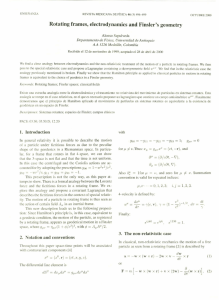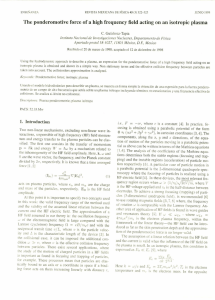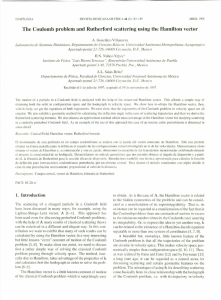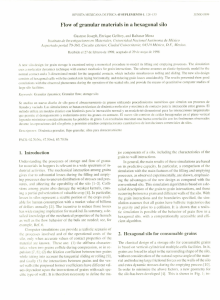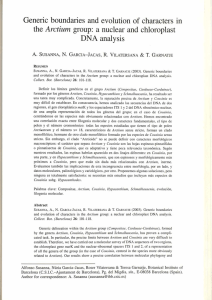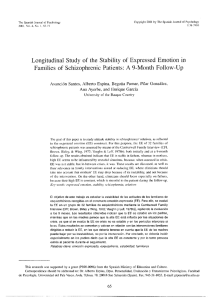Preparation and characterization of functional and non
Anuncio
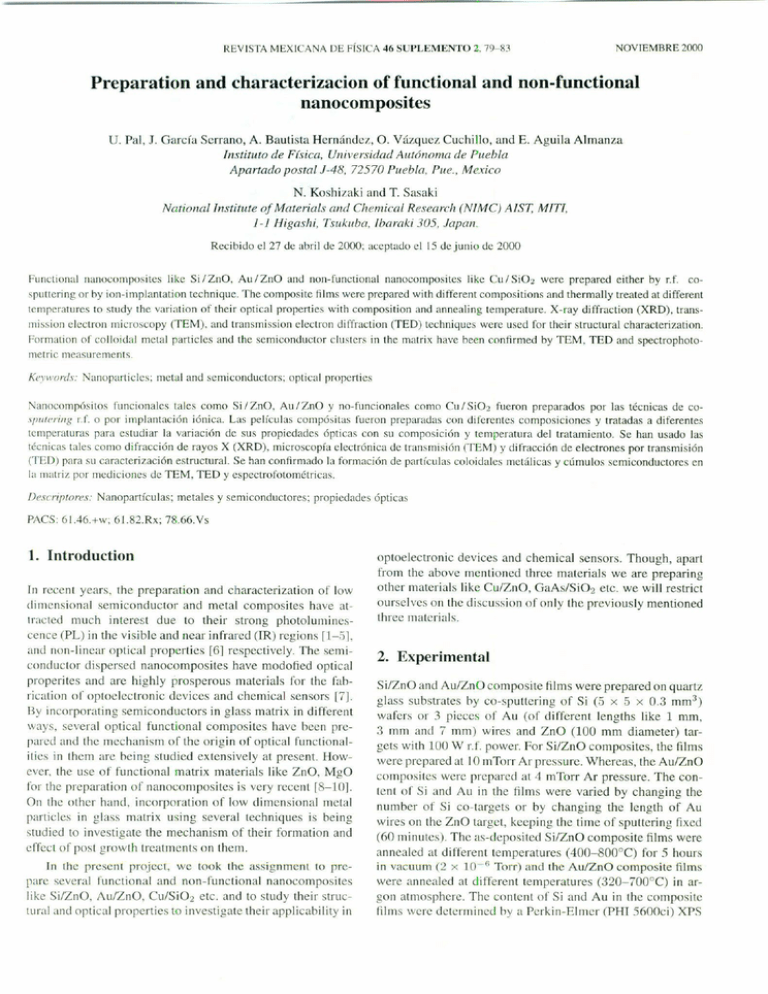
REVISTA MEXICANA DE FislCA -Itl SUPLEMENTO
2, 79-S3
NOVIEMBRE 2000
Preparation and characterizacion of functional and non-functional
nanocomposites
U. Pal, J. García
Serrano,
A. Bautista
Hernández,
O. V;:ízquez Cuchillo,
and E. AguiJa Almanza
Instituto de Física, Unil'ersidad Autónoma de Puebla
Apartado postal J.48, 72570 Puebla, Pue., Mexieo
Natiollallllstitute
N. Koshizaki and T. Sasaki
of Materials ami Chemieal Researeh (NIMC) AlS7; MITl,
1./ Higashi, Tsukuba, Ibaraki 305, Japall.
Recibido el 27 de ahril de 20(X); aceptado el 15 de junio de 2000
Funclional nanocomposites like Si/ZnO. Au/ZnO and non.functional nanocomposites like Cu/SiOz were preparcd cithcr by r.r. cosputtering or hy ion-implantation technique. The compositc Illms wcrc prcparcd with different composilions and thcrmally treated at different
tClllpcratures lo study the varialion 01' thcir oplical propcrties wilh cOlllposition and annealing temperature. X.ray diffraction (XRD), transIllission clcctron mkroscopy (TEM). and transmission elcctron diffraction (TED) techniques were used for their structural characterization.
rormatioll of colJoidal metal particles and Ihe semiconduclor c1uslcrs in the matrix have been confirmed by TEM. TED and spectrophotolllctric measurements.
KeYlI"orlis: Nanoparticlcs:
melal and semiconductors;
optical propcrties
NnnocompósiloS funcionales lales como Si / ZnO. Au / ZnO y no-fullcionales como eu / Si02 fueron preparados por las técnicas de cod. o por implantación iónica. Las películas compósitas fueron preparadas con diferentes composiciones y Iratadas a diferentes
temperaturas para estudiar la variación de sus propiedades 6pticas con su composición y temperatura del tratamiento. Se han usado las
técnicas tales como difracción de rayos X (XRD). microscopía electrónica de transmisión (TEM) y difracción de electrones por transmisión
(TED) para su carncterización estructural. Se han conllrmado la formación de partículas coloidales metálicas y cúmulos semiconductores en
la matriz por mediciones dc TEM, TED Y espectrofotométricas.
.\pu/t'I"ing
DescripTores:
rAes:
Nanopartículas;
6i.46.+w;
6i.82.Rx;
metales y semiconductores;
propiedades óplicas
78.66.Vs
1. Introductilln
In recent ycars. the preparation
and charactcrization
01' low
dimensional
semiconductor
ami metal composiles
have atIracled much interest due to their strong photolumincsccnce (PL) in Ihe visihle and ncar infrared (IR) regions [1-5].
ami non-linear optical properties [61 respectively. The semiconductor uispcrsed nanocomposites
have modofied optical
properiles ¡¡mi are highly prosperous
material s ror the fahrication 01' optoelcctronic
uevices and chemical sensors liT
By incorporating
semicnnductors
in glass malrix in difTcrent
ways. several optical functional composites
have heen prepared and the mechanism 01' the origin nf optical functionalities in thell1 are heing studieu extensivcly al present. How.
cver, the use 01' fllnctional malrix materials like ZnO. MgO
rol' the preparation 01' nanocomposiles
is very recent IS-HII.
On the othcr hand, incorporation
of low dimensional
metal
particles in glass matrix lIsing several tcchniqlles
is heing
stlldicd to invcsligale lhe mechanism 01' lheir formatinn anu
elTecl nI' post growth treatments
on them.
thc prcscnt projcct. wc took the assignmcl1t lo )"'lIT.
pare several fllnctional anJ non-functional
nanocolllposites
likc Si/2nO. AlI/ZnO, eu/SiO:.! etc. ami to stlldy lheir struc(mal and optkal properties lo invcstigate their applicahility in
111
optoelectronic
devices and chemical sensors. Thollgh, apart
frorn Ihe ahoye mcntioned thrce material s we are preparing
other materials like Cu/ZnO, GaAs/SiO:.! etc. we will restrict
ourselves 011 the discussion 01' only lhe previously mentioned
three materials.
2. Experimental
Si/2nO and Au/ZnOcornposite
flIms wcrc preparcd on quartz
glass suhstrates hy co-sputtcring
01' Si (5 x 5 x 0.3 rnrn3)
wafers or 3 pieces 01' Au (01' diffcrent lengths like 1 mm,
:3 mm ami 7 lllm) wires ami ZnO (lOO mm diamcter) targets with 100 \V r.f. power. ror Si/ZnO composites,
lhe films
were prepared al I () mTorr Al' pressure. Whcreas, lhe Au/ZnO
compositcs \\'cre prep~lrcd al 4 mTorr Ar pressure. The conIcnt 01' Si and Au in the nJllIS were varicd hy changing the
numher 01' Si cO-largels or hy changing
the length of Au
wircs on Ihe ZnO larget, kceping the time 01' spultering fixed
(60 minulcs). Tilc as-dcposilcd Si/ZnO compositc films wcrc
anncaled al di!'!'crcnl Icmpera!ures (400-800°C) !'or 5 hours
in vacuutll (2 x 10-(; Ton) ami thc Au/ZnO
compositc
lilms
werc annealed at ditTcrenl tcmperaturcs
(320-iOO°C) in argon atmosphere. Thc COJltcnt nI' Si and Au in the composite
IiIms wcrc dctcnnined
hy a Perkin.Elmcr
(PHI 5óOOci) XPS
Sil
u.
syS1CIll. X-fay ditTractioll,
TEM anJ TED lcchniqucs
I'.\L
I1
di
\VeTe
uscd rol' Ihe slructural charactcrizalion
of lhe fIIms. Por TEM
ami TED ohscrvations.
Ihe compositc f1Ims of ahout 25 nm
thickncss with diffcrcll( Si/Au conlcnts wcre dcpositcd on
carholl-coalcd
NaCI sUOslratcs. Thc lllms artcr transfcrring lo
Ihe coppcr grids wcrc anncalcd
al diffcrcnt
tcmpcraturcs
and
hy "JEOL JEM2000-I'XII eleetron microscopc. A
SHI~IADZU(UVJ 101 pe) doublc beam spcctrophotomctcr
inspcctcd
\Vas uscJ
rol' lhe IllCaSUfCI1lCnt 01' oplica!
lihns. A Nicolct Magna
record Ihe IR ahsorptioll
ahsorption
in Ihe
750 FfIR spcClroll1CICr was lIscd to
spcclra of Si/ZnO composilcs in dir.
fuse modl'.
Thc Cu/SiOl
compositcs
\VeTe
prcparcJ
hy implanling
:2.0 ~lcV Cu+ ion s in rusco quartz g!ass subslralcs using a
:~ f\kV Tandclll acccleralor.
Kecping Ihe ion currenl flxcd
lo 1.;-) 'IA, lhe salllples were prepared wilh difTerent nominal <.loses like 5 x 101"" (salllple a), !) x lO!!) (sample h),
ami 1 x IOIló (sample c) ions/cm2, RlIlhcrford hackscattering
(al
F[(ilIRE
l. Typical
th)
TE~I
SODor: ~lI1ncaled Si/ZnO
micrographs
films prepared
ser! of (h) shows ¡he TED pattcrn
speclromelry
(RBS). using: ,1.0 t\1cV Hc+ ion s has heen cmplOYl~dlo sludy lhc dcplh proliles 01' el! in lhe suhslralcs after
illlplanlalion.
For lhe :Inalysis of deplh prollles, Ihe prog:ram
of (a) as-grown
and (h)
wilh samc Si contento
taken on
ti
In.
micro-cluster.
04
RU~11' (RlIthcrfonllllliversalmaipulation
program) 1111. in
comhinalion
wilh Ihe results 01' RES measuremcnls
have
hecn lIscd. Optical ahsorplion
measurcmenls
were dome al
02
room tcmperature
in Ihe il1lcrval 01' IDO to 700 nm lIsing an
un-illlpl:mled suhstrale as referencc.
3. Reslllts and disCllssion
Si/ZIIO
lile
SilZn alomic
ratio was calculated
from Ihe Si2!':!j:.! ano
Zn2!':ij2 peak arcas in XPS spectra 01' the liIms. Contenl 01' Si
inlhc lilms incrcased wilh Ihe incrcase of Si picccs ami could
casily he conlrollcd hy changing Ihe numher 01" Si pieces on
lhe ZnQ largel.
Figure l sI1o\\'s Ihe Iypical micrographs
01' as-deposiled
aIll180f)°C annealcd SilZnO films. For the as-deposilcd films
we can ohserve the nanoparlicles
01' size ranging fmm :2 10
-l nm dispersed
in lhe lllatrix. 011 :ulncaling al íOO°C or
highcr lempcratures.
the nanoparlic!cs
aggregalcd
10 rmm
higger c1usters (lllicro-c1usters
thcre after). In rig. l h \vc
can .'ice Ihe micro-c1usters
of 10 lo 60 nm sizc (average size
.q nlll) rOfmed afler annealing Ihe film at 800°C. The avcrage
size 01' Ihe clUSlcrs did nOI depend Illuch on the Si conlenl in
lhe films. lIo\Ve\'cr. lheir Ilulllher densily
incrcasc of Si conlent in lhe films.
increased
witil lhe
The positioll 01' Ihl' Si2/' cmission in Ihe XPS spectra \'ar¡ed from 101.6 lo I02.X eV which is in hetween Ihe peak
POSiliolls (11' elemental
Si (99.2 eV) and SiOl (103.9 eV).
So, in Ihl' cluslers,
Si rcmained appan:nlly
in lhe SiOx
((J < _\"< :2) chcmical slale.
IR ahsorplion sllL'ctra 01' the films revealeJ several peaks
inlhe IOO-iOO cm-I spectral range. There appeared a hroad
llon-sYlll111l'lric peak for alllhe samplcs,
v:tricd sysll'malically
with Ihe varialioll
Ihe positioll nf which
01' Si c:ontcn( alll!the
Rel'.
)\f¡>\,
F[(;lIRE
2. Evollltion
oflR
ahsorption
alme ans its computcr-simulalcd
prcparcd
peak wilh annealing
dCCOlllpositions,
tempcr-
for a SilZnO
film
with 1 ó Si ('o-largets.
lemperature 01' annealing of Ihe lIIms. A compuler-simulalcd
decolllposilion
01' these complex peaks showed two adjacenl
hands in them, Ihe position 01"which \'ary wilh Ihe contenl
01' Si in Ihe films am! also with Ihe Icmperalurc
01' annealing. In rig. 2, the evolulion
annealing Icmperalure,
position are presellled.
01' Ihe peak with Ihe varialion
01'
anJ lheir cOl11puler-sil11ulated decol11Both lhe componcnt hamJs moved 10-
wan!s shorter \vavelcngth with Ihe incrcase 01' annealing (cmpcralurc, The longer wavclength side hanJ movcd from 485
lo ;j2;j cm~ l. whereas lhe shortcr wavelenglh
hand moved
frlllll ;) I 210 5;")0 CIll-1 . \Ve assign Ihese Iwo sets of hands to
Ihe Si-Si slrclching
FiJ . .t6 S2 (2000¡ 79-X3
aS)'ll1ll1elric (SA) and strelching
symmel-
I'I<EI'/\RATiON
.J\NI) ClIARACTERIZACION
]
o
c:
ro
-eo
''''''' '000 -
"""-
A"
(220)
o
0.2
.,
0.0
f
:: 1...._S_'_'_0 __t._r9
••_to==~.
0'9100
420
440
460
480
500
Wavenumber
F[<;UR[
ZnO wilh
'000
.c
'"
«
ZnO with 3 pes. of 7.5 mm Au wire
'000 -
~
Q)
XI
OF FUr-.;CrIf)NAL ANI> N();-"¡-FUNCTI()~:\L NANOC()~1P(}SnlS
J. IR :lhsorrlinn
diffcl"cllt Si contcnts.
spcctra
520
540
560
580
for Si/ZnO
'''''''
'000
"""
cornpositc
films \\'ílh
~
A"
(331)
ZnO wilh
(422)
3 pes _of 1 mm Au wire
'''''''
'000
o
'000
ZnO
'"O
'''''''
'000
anncalcd al ,HlO°C.
~
(220)
o
'000
"""
(cm"')
3 pes. of 3 mm Au wlre
(002)
'00
(103)
ril: (SS) vihrations [11) in Si] clustcrs. rcspccti\'cly. A reverse ctlect is ohscrved 00 itH.:rcasing lhe Si cnntenl in lile
I1ll11s.\Vith lhe incrcasc of Si contento lhe ahsorption peak
shiftcd towards tonger wavclcnglh. \Vith (he ¡nercase of Si
content, lhe intcnsity 01' Ihe peak increascd sharply ami its
posilion shiftcd
from 517 lo 480 cm-l.
"""
'00
('02)
o
40
Bragg angle
'0
2(-)
60
(degrees)
60
F[(iURE 4. X.ray lJi!lr,Ktioll spcctra for Au/ZnO composites prcpared wilh di1'fercnt Al] COlllents.
Thc ahsorption;1I
about '¡S5 ami 508 cm-l corrcspond 10 lhe tripiel cxcilcd
slales "13, (C~,,) and "A, (D:I/,) of Si", respeelively [12J. The
JlL';¡ksappcarcd al ahout 525 ano 550 cm-I corrcspond 10 lhe
ahsorption of single! graund slale 1 At(C:lv) of Si:l. So, as lhe
lcmpcraturc 01' anncaling ¡ncrcaset!, lile conflguanion 01"Ihe
Si <1101115 in Si:t clustcrs changcd fram lile tri piel lo lhe sin4
~Ict ground slalc. Thc 507 <lm1532cm~l ahsorptions ([Oig . .3)
corrcspond lo lhe mosl stahlc lr¡plel 3Al (C2,,) sIate of isosccles slruclUrc and lile sccond mosl stablc tri piel state ol" linear
chain slructurc 01' Si;-¡. rcspcclivcly 113J. SO, as lhe Si contenl
in Ihe films incrcascJ, (he Sh cluster in Ihe films acquircd lhe
lesscr slahle gcoll1ctrical struclurc.
,\u/ZnO
In Fig. 4, XRD spcctra 01' lhe as-dcpositcd fllms \••..ith Jifferclll Au contcnts are showll. Wilh lhe incrcasc nf Au conlen\. Ihe inlensity uf Ihe (220), (331) and (422) peaks of Au
¡n(,fcascd. Therc ~rpearcd a peak corrcspol1ding lo Ihe formatioll of AuO, inlcnsity of which also ¡ncfcased with th¡,;
incrcasc of Al! content in Ihe films.
In Fig. 5. (he TEM micrographs of lhe compositc fIIms
with same Al! contcnl bUI anl1calcd at dirrcrcnl tcmpcraturcs
are shown. Formation 01' Au nanoparticlcs
in lhe fllms is
clcar. \Vilh Ihe ¡nercase of <lllllcaling tcmpcraturc, (he average sile 01' lhe Al! particJcs incrcascd.
Forlllation 01' nanomctric Au p:trticlcs in Ihe films is ;lls()
cvidcnt frorn lhcir oplical ahsorption spcctr:l. In Fig. 6, optical ahsorption "pcctrn 01' a film prcparcd wilh 3 rieces nf
7 Illlll Icngth Al! wircs ami :mncalcd al diffcn:nt lcmpcralurcs
are shown. Thc arrcarancc 01' a hump llc;¡r abollt 2.3 cV in
Ihe srettra corrcsponds to plasman absorption in Ihe sm:111
(a)
(h)
(e)
(d)
FIGURE 5. TEi\l
Illicr{l~rap!ls 01' (,,) as-grown,
(e) ,500°C :lllU (ti) i"OO°C anncaletl
3 pieces 01' 7 mm Au cO-I:lrgcls.
Rel'. Ml'x. Fú. 46 S2 (2000) 7<J-X3
AulZnO
nlms
(h) 320°C.
prcpared with
Xl
1J. I'AI. ("
8.01
1//
~---
o
AulZnO prepared with 3 pes. 01 7mm Au wires
a- 7AuZnO (r.l)
60
/
/
-
-
~_---=::::::::--
~-----
n
///
00
40
E
!2
a
/
2°l/
20
b /"
/
I
I
e
/
,
40
sample - e
/
b. 7AuZnO (3200C)
c. 7AuZnO (5000C)
d- 7AuZnO (7000C)
;:;
o
,/~-
sample • b
e
o
d
20
~
eal
u
e
o
00
20
u
"
O
00
1.4
1.6
1.8
2.0
2.2
2.4
2.6
2.8
3.0
sample - a
32
Photon energy (eV)
P[r.URE
6. Opti('al
allncaled
at dillcrcllIlcmperatures.
ahsorption
speclra
01" a AlI/ZnO
10
composilL'
1¡lm
00
Au p~lrticles. The plasmon ahsorptioll peak shiftcd lowanb
lov.'cr cnergy as Ihe tcmperaturc of annealing increased;
which is in agrcclIlcnl with Ihe ohservalions made from TE!\l
study that lhe avcragc sizc of Au particles ¡ncreases wilh Ihe
incrcasc of annealing lcmperaturc.
05
00
20
15
25
30
in "ilica glass fUf diffcrcnl
irnplan-
1 O
Depth (microns)
Fl(;LIRI: 7. [)epth prntilcs
ofCu
[;lliont!O"es
20
en/SiOl
.- .
Figurc 7 shows Ihe dcplh profile 01'Cu in silka glass ror different doses 01' implantation. \Vilh lhc ¡ncrease implantation
dose lhe principal dislrihution al' Cu hecornes sharpcr, more
inlense and ilS posilioll shifts towards lowcr depths. On lhe
inCrCi.L'ie
01'implantation dose, there appcared other pcaks at
lowcr dcpths, and thc maio dislrihution transformed fmm the
hilllodal lo a Gaussian onc. These hchaviors can he cxplain
by cnnsidcring lhe intcraclion the Cu ions among thcmselves
and wilh the malrix 114J.
The oplical ahsorplion spectra for lhe samples a ami h
are shown in Fig. R. There appeared two c1ear peaks in
the ahsorplion speelra. The peak appeared al aboul 560 nm
(band 1l. is the eharaeteristie ofthe formal ion of co1loidal el!
nonopartic1es 1151. The olher peak elose lo 215 nm (hand 2).
has heen reported hy several workers [15, lO] and assigned to
¡he E'uet'cct in silica glass crcated during implantalion. With
Ihe increase of implantation dose, lhe bano ) became clearer.
sharper. ami shiftcd slowly towards highcr wavelengths, indicaling lhc growth nf particles.
The thcoretically calculalcd ahsorption speclra for lhe
samplcs are prescntcd hy rhe data points with diffcrcnl SYIllhols in the same figure (Fig. 8). For the silllulation 01" oplical
ahsorption srectra, we used thc Maxwcll-GarnCtllhcory with
"mean frce palh" correctioll for the dicleclric functinn 01'the
n<lnoparliclcs. The dClails oí' lhis models can he found in
Re\'. M('x. Ft\' .
.t(1
Sample a
, ,
'
16
~
~
E
•O
12
4-
•
..
:
¡
U
lE
.
8
U
!
•
.I
••••••.
~
8
.:
..
r)iJ
Sphere (R= 10 nm)
Oblate spherold (R= 12 nm)
Sample b
Sphere (R= 14 rvn)
Oblate spheroid (R: 14 nm)
[J
o
~
.o
'"
.;
4
------,-
O
150
250
350
450
Wavelenglh
550
650
750
850
(nm)
FI(;URE X. Ahsol'Plioll spcclra 01' Cu/SiO~
Ihcir lhcorctir.:al lit:-..
samples (a anJ h) and
ReL 17. The simulations are rcali/ed hy taking Iwo forms
01' lhe particlc. spheres ami ohlate spheroids. For Ihe salllpie a. prcparcd wilh lowcr implanlalion dosc. Ihe theorcti.
cal lltling is hctlcr when Ihe sphcrical shapc 01' Ihe paniclcs
S2 (2000) 79-XJ
I'REI'ARATIO:"J ANO C1IARACTERIZACION
OF FUNCT1():"JAL AND NON-FUNCTIONAL
is cOllsidercd. On lhe olher hand. for lhe samples prepared
wilh highcr implantation dase, lhe thcorctical spcClra fitted
\\.'cll with the experimcntal speclra when an ohlale spheroidal
shape ()f the particles is cOllsidercd. In the samples prcpared
wilh lowcr implanlalion dose, as lhe average size of Ihe parfieles is small. a spherical shape for Ihem is expected. \Vith
(he incfease 01" implantation dosc, lhe el! particles grow. and
prohahly takc some irregular fmm devialing from their regular sphcrical shape.
4. Conclusions
Si ami Al! clus{crs can be preparcd in ZnO malrix by rJ. cospultering lechnique. Thc Si cluslers, formcd in SilZnO COI11posilcs. cOllsis! 01' a eore of Sh ami a SiOx cap ¡ayer arollnd
thclll.
Al! nanoparticles formed in ZnO matrix remain mostly in
i(s elemental state wilh an oxide layer at Ihe partiele-matrix
1.
s. lIaya~hi.
ti YY3) 274.
r..1. Kalaoka,
and K. Yammnoto. 1. AI'I'I. Phys .• '2
2. S, Yoshida. T. Banda. S. Tanahc. anJ N. Soga. l/m. 1. AI'I'I.
I'h.r.\". -'5 (1996) 2694.
:1. Y. r..1aeda
('t (/1.. AI'I'I.
.1. Y. Kalllawa
Phys. U'U. 59 (1991)
i'/ (/1.. Solid
S/ate
COIfIIfIIlII.
J 16X.
1U2 (J (97) 533.
.). S. lIayashi. T. !\'agareda. Y. Kanzawa. anJ K. Yamamolo. 11m.
./. AI'/'/' Phys .. '1 (1993) 3840.
G. R.II. lIaglllnd el (/1.. Nuc!. Imtr. amI Mi'lh. Phys. Res. B 91
(1994) 493.
/. N. Koshil.aki. K. Yasumoto. and S. Tcrallchi. l/m.l. AI'I'/. Phn ..
.14 (slIrpL 34-1)(1994) t19.
8. N. Koshi/.aki
9
('1 al.. NallOSlntet.
M(//t'Y,
K (1997) 403.
U. !'al, N. Koshizaki, S. Tcrauchi. and T. Sasnki. Afierose. Afi8 (1997) 403.
emall(/1. MicnJs/rucl.
NANOCOMPOSITES
83
inlerface. The size of Ihe nanopartic\es can be conlrolled by
conlrolling cilhcr by the contenl 01" Au in Ihc films or by conIroIlillg the temperature 01" allllcaling.
()islrihulion 01' Cl! in silica tlepenos on the implanta(ion dose. With Ihe increase 01' implantation Jase, Cu segrcgale towards suMstrale surface. For the samples prepareJ with
low implalltation Jase. the si/e of Ihe Cu particles is very
small amI the nalural sphcrical shape retain in them. With
the increase of implanlation dose. the size 01" the Cu parti.
ele incrcase anJ their shape Jeviate from spherical lo oblalC
sphcroidal.
Ackl1llwled¡:ments
Wc are thankfullO Dr. L. R.oJrigue/-Pernández and Dr. J.C.
Chean- \Vong rOl" preparing Cu/Si01 samples and lheir RllS
analysis. The work is supp0rled by CONACyT (Grant no.
283XO.E), Mexico.
10. G. Zhao, H. KOluka. and T. Yoko. Thirl So/id Films 227 (1996)
147.
11. S. Li, R.J. Van Zcc. W. Weltner Jr.. and K. Raghavachari. Chem.
/'hy.,. /A'II. 24.1 (1995) 275.
12. c.~1. Rohlfing and K. Raghavachmi, 1. Chem. Phys. 96 (1992)
2114 .
13. R. Fournier. S.B. Sinnou, and A.E. DePrislo, l. Chem. Phys. 97
(\1)92) 4149.
14. A. Bautis(a-Hcrnández. U. Pal. L. Rodriguez-Fernández,
J.c. Cheang- \Vong, Superficies y Vacio 9 (1999) 296.
and
15. P. Mazzo1di, F. Cacea vale, P. Chakraborty, R.A. Zhur, and G .
Whichard.l. Nrm.Cry.{. Sol. 129 (1991) 46.
tG. tUl.
MagruJer
1tI el al .. J. AI'/'1. /'''.1'5. 76 (1994) 708.
17. R. Ruppin. l. AI'I'/. Ph\'S.,59 (19R6) 1355.
R('l'. M('.\'. Fú .. U. S2 (2000) 79-RJ
